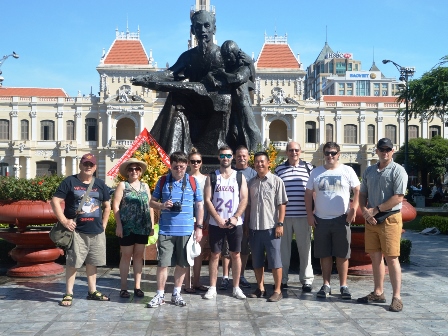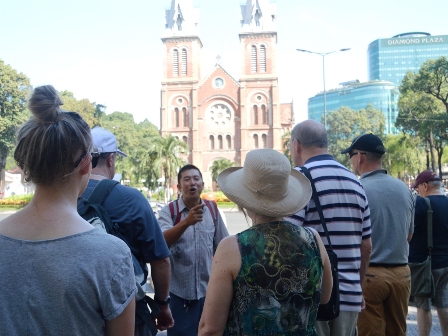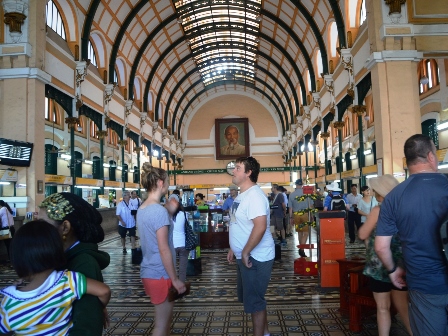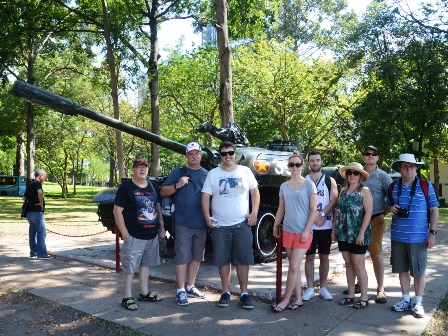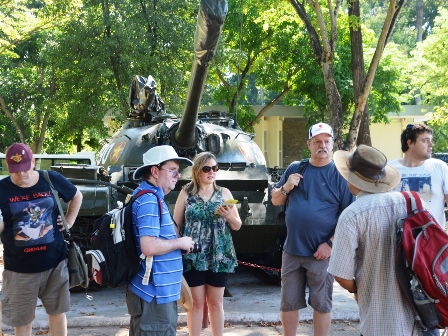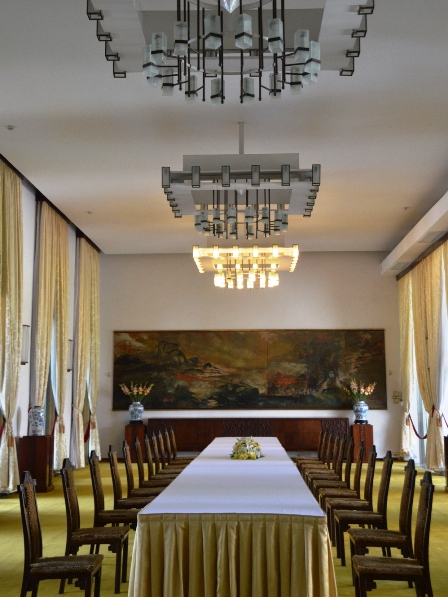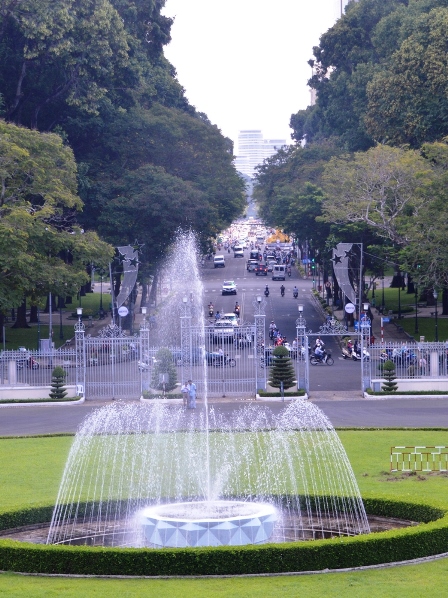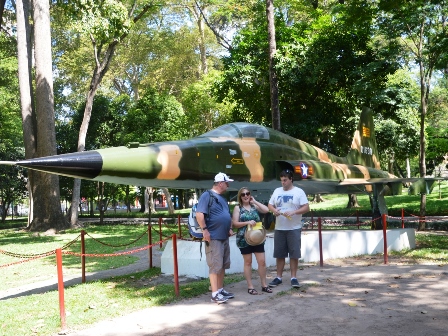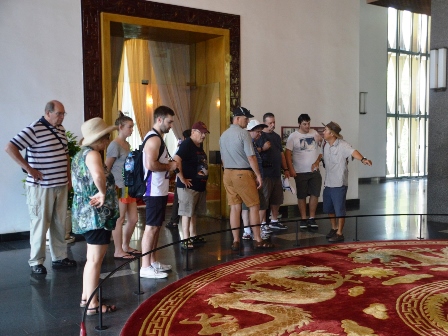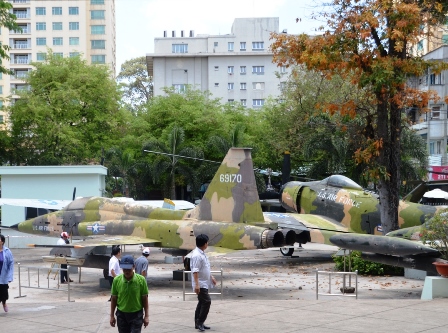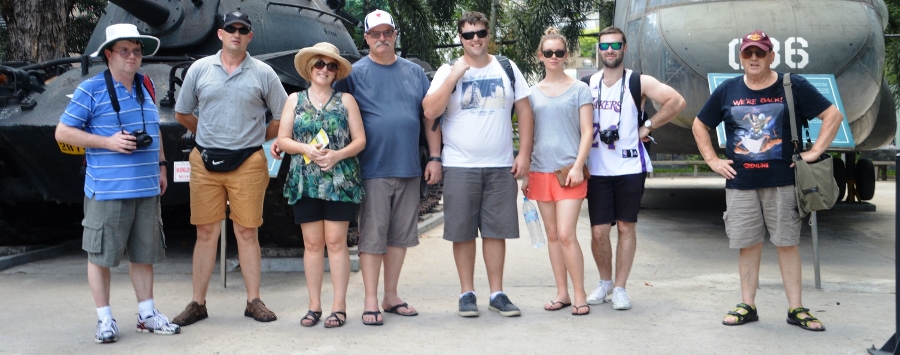Our first day proper begins with a short walking tour from the Liberty Central hotel, near Ben Thanh market, to the centre of the city. Notre Dame Cathedral, the city hall and the central post office, designed by the same M. Eiffel who built the tower in Paris are fairly obvious reminders, if any were needed, that Saigon was once the jewel in French Indochina’s crown.
Along the way our tour guide Tam points out the rooftop of the former CIA building which was the scene of that famous iconic picture of people desperately trying to get on the last helicopter out of Saigon before the city finally fell to the North Vietnamese in 1975.
An all-too-short bus ride (thank heavens for air conditioning) takes us to the former Presidential Palace with tanks in the grounds that are the same tanks (but not the exact ones) that crashed through the gates on that fateful day. There is also a similar (but different) jet fighter to the one used by a turncoat South Vietnamese pilot to bomb the palace in the closing months of the war.
The real tank and plane are in the war museum in Hanoi, the capital. But it seems that in this, the booming capital of replica watches and “end of run” but genuine clothes, bags and shoes, even some of the military relics are knock-offs.
The palace is opulent and extravagant, and its award winning architecture is worth a visit alone. But it’s the subtext of privilege, revolt, betrayal and assassination that tells the whole story. Upstairs has the elegant reception rooms, furnished and fitted out in a style better suited to European princes than a struggling Third World economy.
Downstairs in the basement there is all the evidence of the other side of the story. Bunkers built to withstand a direct hit from a 500 pound bomb contain planning and communications rooms. Ancient radio equipment that probably has less grunt than your average mobile phone fill map-lined rooms. A secret passageway leads directly to the president’s offices upstairs. A secret tunnel leads to another official building, the railway system and the Saigon river. The South Vietnamese and American led allies may have been planning for victory but were well prepared for defeat.
Another short bus ride takes us to the War Remnants Musem – previously called the American War Crimes Museum., before diplomatic thawing and typical Vietnamese pragmatism and business sense prevailed and the anti-American propaganda was toned down a lot. By the way, the Australian contribution barely rates a mention, typified by the displays at Cu Chi tunnels (which we will visit tomorrow) where not only do they fail to recognise that they were discovered by Australians, but fails to acknowledge that Aussies were ever actually there.
The highlights for most of us were the captured American military vehicles parked in the forecourt- fighter jets, tanks, helicopters and field artillery, the tiger cages and guillotines used by the French to behead Viet Minh insurgents, and the amazing gallery of photographs of the war taken by foreign Press photographers. The display of the effects of Agent Orange on subsequent generations of Vietnamese was a bit too confronting for some of our group.
Lunch in a pho restaurant offering a wide range of two noodle soups – OK, it was just beef or chicken- is an opportunity to prepare for the next day’s trip to Cu Chi with our No 1 Tunnel Rat, Sandy MacGregor explaining how, as a young captain, he and his men in 3 Field Troop had discovered the tunnels and had explored them (at a time when American troops were specifically ordered not to do so). Sandy’s chat and a TV min-documentary on the tunnels were the icing on the cake after a simple but tasty meal.
Our next stop was the atypical Bitexco tower, at 44 storeys by far the tallest building in Saigon with a viewing gallery near the top offering 360 degree panoramas of this city of nine million souls. Later that day some of the group took a cyclo tour of another part of the city (paid in advance to avoid the hassle of the street rip-off merchants) while we all came together in the evening for dinner at the Na Hang Ngon restaurant which serves authentic street food that you can see being prepared in little stalls around the perimeter – but delivered to your table in a more western restaurant setting. Allegations that one of our group said: "I don’t like Asian food – can’t we go to a Chinese restaurant" are being hotly denied.
